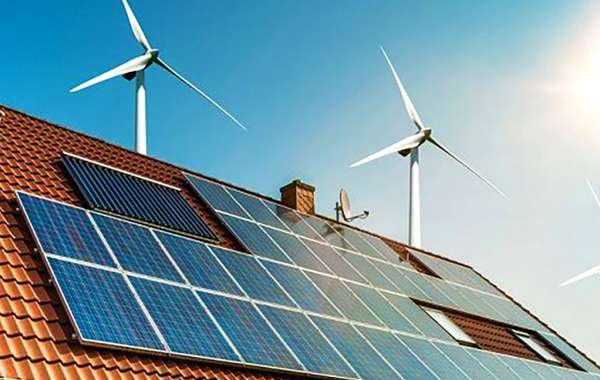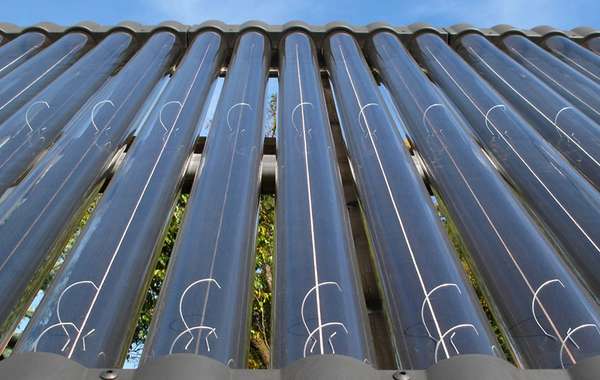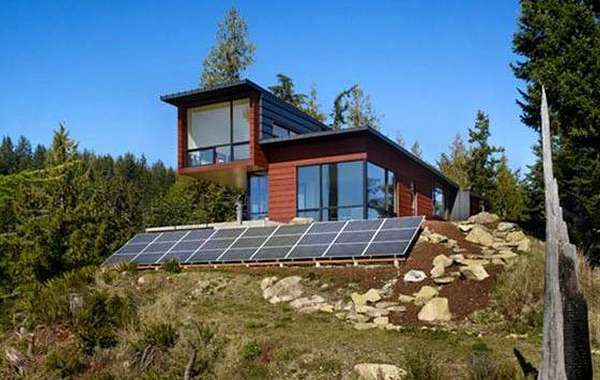New technology combines solar power generation & battery free power storage
The forever-changing landscape of the green home building industry sees ideas come and go, and on occasion a game-changing technology or product emerges. The big news lately is in renewable energy - solar power generation, solar power storage, electric vehicles, and a trend towards electric power tools and heavy equipment. As we face an ever-increasing risk from climate change, the urgency to reduce greenhouse gas emissions and transition to low-carbon construction techniques and renewable power generation is urgent beyond measure, and the current market keeps turning up solutions.
Solar thermal collectors and Stirling engines generate power
One that really impresses us is from a Swedish company named Azelio that offers a solution to renewable energy power storage in an innovative and more affordable manner than we are used to seeing, because they have reversed the customary actions of power generation followed by power storage in big and costly batteries.
Instead, Azelio uses photovoltaic (PV) solar energy and converts it into heat in a thermal battery (or TES – Thermal Energy Storage), then they use a Stirling engine (200 year-old technology to convert heat into power) to generate electricity on demand.
Solar power generation is increasing in popularity at home as well as with utility companies as they rush to inject more clean energy into the grid. But, with the exception of a few industry leaders (such as the Tesla Solar Roof) and other solar shingle manufacturers, innovation in the industry has been relatively drab looking for decades and has mainly revolved around solar PV efficiencies, panel materials and battery technology.
So far, there have been several encouraging green building trends of 2020 that caught our attention, notably an increase in PV solar panels on homes. The implications of what Azelio is doing could be quite significant, and in order to explain that properly requires a quick recap of the more common technologies for comparison:
The difference between solar thermal and PV solar panels
Standard photovoltaic panels absorb photons from the sun, which causes a reaction with electrons in the solar cells, and converts that action into electricity. But one of the drawbacks is that this only happens while it's sunny. To provide a constant power supply requires enough solar panels to account for night time usage, and to be fully off-grid, you'd need batteries to store power for night time use.
Solar thermal collection is a more simple process; it is a matter of absorbing heat directly from the sun in a manner that can be directly stored - but this is really only practical on a direct domestic or small-to-medium sized building,
Solar thermal collection is quite simple; it can be passive solar home design, or solar air heaters or solar thermal water heaters. Heat can easily be stored in thermal mass (also known as a thermal battery), which is nothing high tech – concrete, water, stone, wood, etc., are all examples of thermal mass. As a general rule, the denser something is, the more heat it can store.
The Azelio solar electricity storage
The difference with the Azelio storage system is that it can be easily added at a reasonable cost to regionalized clean energy production like solar PV, wind generators or both, and optimized to store excess electric during the day by using it to produce molten aluminum alloy (luaminum is one of the most widely used and recycled metals in the world, and a very common element in the Earth's crust).
Using the Stirling engine, the heat stored in the alloy is converted into electricity during high demand or at night when the solar PV is no longer generating. It's also "clean" and it doesn't rely on mining scarce minerals the way batteries do.
How a Stirling engine works
To understand how a Stirling engine works, imagine a steam engine where water is boiled, and steam turns a piston. A Stirling engine heats and cools gas, and the gas expands and contracts as that happens. As the gas is heated by the thermal battery, it expands and forces a piston. Gas is cooled in the cycle, then re-heated again by the thermal battery. This process is repeated about 25 times per second.
We find this very impressive, because it is in part indicative of a revival in solar thermal heat storage systems, which was starting to go the way of the VCR in the age of Netflix, due to the improving efficiency and dropping prices for PV panels and the ready availability of battery storage - albeit expensive. To understand how valuable this could be, we first need to look at the current technology, which is all very impressive in its own right.
Phase change building materials
A ‘phase change’ refers to the action of a material changing from liquid to solid to gas, or in the reverse order. Even greater heat storage capacity can come from employing Phase Change Materials (PCMs).
A significant amount of energy is absorbed or released when a material changes phase, which is the central part of Azelio’s process. Heat is stored in a container with a phase change material - in this case molten aluminum, which is heated up to just under 600°C and liquefied by using the electricity from solar PV or wind generators.

Storing renewable energy
One downside of injecting clean, renewable energy into the power grid is that many green power sources lack predictability, making balancing the supply more challenging. Power authorities work hard to anticipate supply and demand so they can provide sufficient power when needed, without over producing.
Hydro electricity can be balanced somewhat without significant changes in water levels, but solar and wind (arguably the more eco-friendly renewable energy sources, but let’s not open that can of worms now) are not overly-predictable, since they rely on weather reports to anticipate supply.
A tip of the hat to meteorologists, but it’s still guesswork and I’m sure we’ve all been stuck in a surprise rain shower at some point while expecting clear skies, so predictability is incredibly valuable. And you can’t simply put a nuclear plant in idle, so overproduction of power can be a big problem. In some cases of overproduction and reduced demand, power needs to be dumped to other states and provinces at discounted rates, assuming they have the capacity to accept it.
This is where the solution offered by Azelio is so advantageous since this heat (or ‘latent electricity’ if you will) can be stored until needed. Stored power such as this facilitates the greening of electrical grids with cleaner power, by offering a balanced supply.
Home solar batteries
To date, there is no home power storage solution from Azelio, but if this new technology stands the test of time, it is almost a foregone conclusion that at some point someone will pluck that ripe apple from the tree and develop a residential solution.
PV panels on your roof can reduce your personal energy consumption, but without home power storage you are still reliant on grid power. The latest lithium-ion technology in home batteries and power storage is still not terribly efficient, and so consequently, it is still quite expensive.
The best lithium ion home batteries will run you roughly $10,000 USD to install just one, and to meet the energy consumption needs of most homes you would likely need two of them. We don’t all have 20k burning a hole in our pockets to store power for an emergency; that’s why you don’t see a lot of them just yet, but home power storage is, in our opinion, another one of those inevitable design features of the future.
Future-proofing homes
With increasing global uncertainties in terms of climate change and the "out of our control" destabilization of markets, economies and governments, there is a sub-culture of off-grid preppers that seem less and less nuts to the mainstream population with each passing day.
Proof is in the pudding, and as people now feel vulnerable and scurry to stockpile essentials during the Coronavirus outbreak (which even at this early date in its incubation is already being called the greatest upheaval of a generation) our guides such as vertical wind turbines and emergency preparation have been some of the most visited!
Now you know more about solar electricity generation & storage without batteries and how it can help reduce the carbon footprint of eco homes & sustainable construction...Find more pages about sustainable and resilient green building techniques here :
Find more about green home construction in the Ecohome Green Building Guide pages - Also, learn more about the benefits of a free Ecohome Network Membership here. |





























Comments (0)
Sign Up to Comment